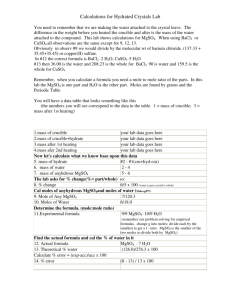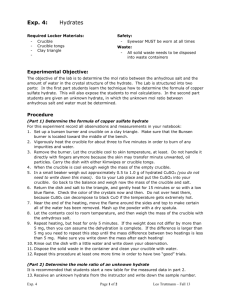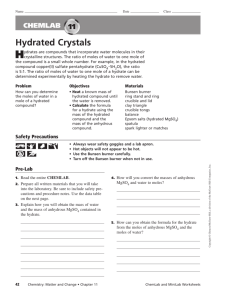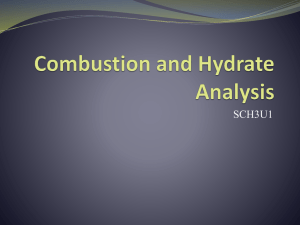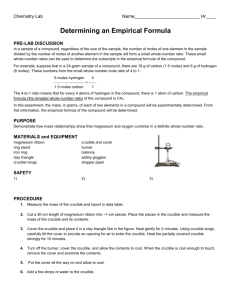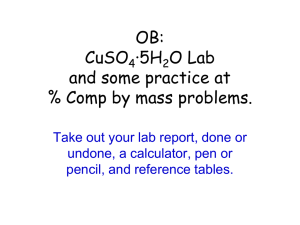Water of Hydration 2
advertisement
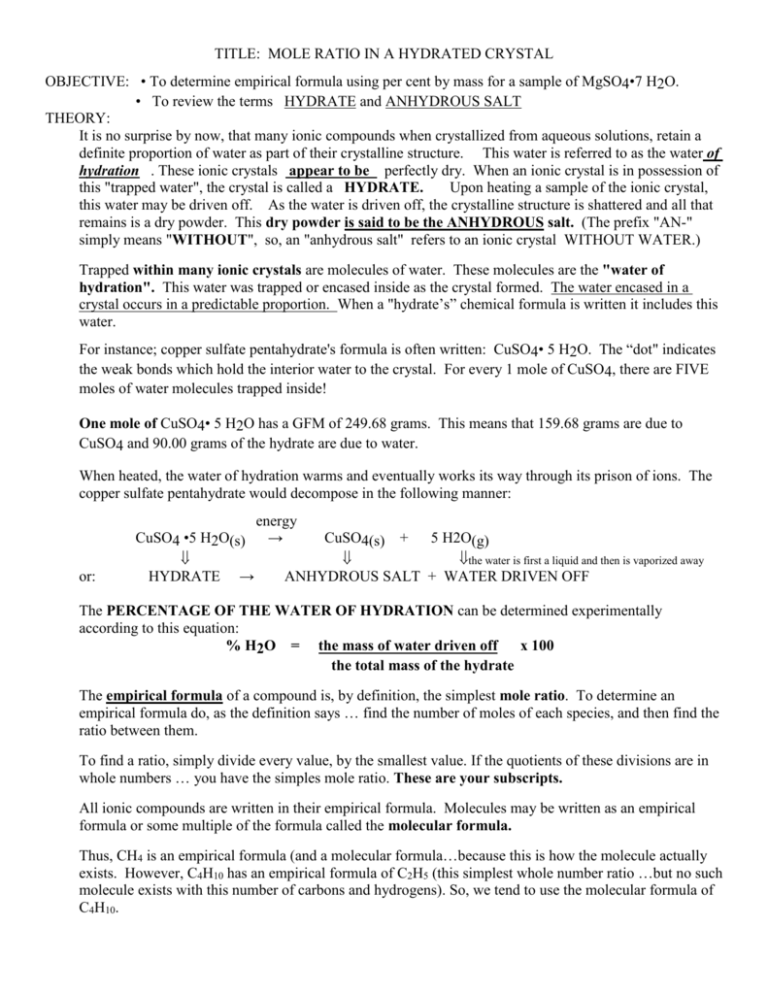
TITLE: MOLE RATIO IN A HYDRATED CRYSTAL OBJECTIVE: • To determine empirical formula using per cent by mass for a sample of MgSO4•7 H2O. • To review the terms HYDRATE and ANHYDROUS SALT THEORY: It is no surprise by now, that many ionic compounds when crystallized from aqueous solutions, retain a definite proportion of water as part of their crystalline structure. This water is referred to as the water of hydration . These ionic crystals appear to be perfectly dry. When an ionic crystal is in possession of this "trapped water", the crystal is called a HYDRATE. Upon heating a sample of the ionic crystal, this water may be driven off. As the water is driven off, the crystalline structure is shattered and all that remains is a dry powder. This dry powder is said to be the ANHYDROUS salt. (The prefix "AN-" simply means "WITHOUT", so, an "anhydrous salt" refers to an ionic crystal WITHOUT WATER.) Trapped within many ionic crystals are molecules of water. These molecules are the "water of hydration". This water was trapped or encased inside as the crystal formed. The water encased in a crystal occurs in a predictable proportion. When a "hydrate’s” chemical formula is written it includes this water. For instance; copper sulfate pentahydrate's formula is often written: CuSO4• 5 H2O. The “dot" indicates the weak bonds which hold the interior water to the crystal. For every 1 mole of CuSO4, there are FIVE moles of water molecules trapped inside! One mole of CuSO4• 5 H2O has a GFM of 249.68 grams. This means that 159.68 grams are due to CuSO4 and 90.00 grams of the hydrate are due to water. When heated, the water of hydration warms and eventually works its way through its prison of ions. The copper sulfate pentahydrate would decompose in the following manner: or: energy CuSO4 •5 H2O(s) → CuSO4(s) + 5 H2O(g) the water is first a liquid and then is vaporized away HYDRATE → ANHYDROUS SALT + WATER DRIVEN OFF The PERCENTAGE OF THE WATER OF HYDRATION can be determined experimentally according to this equation: % H2O = the mass of water driven off x 100 the total mass of the hydrate The empirical formula of a compound is, by definition, the simplest mole ratio. To determine an empirical formula do, as the definition says … find the number of moles of each species, and then find the ratio between them. To find a ratio, simply divide every value, by the smallest value. If the quotients of these divisions are in whole numbers … you have the simples mole ratio. These are your subscripts. All ionic compounds are written in their empirical formula. Molecules may be written as an empirical formula or some multiple of the formula called the molecular formula. Thus, CH4 is an empirical formula (and a molecular formula…because this is how the molecule actually exists. However, C4H10 has an empirical formula of C2H5 (this simplest whole number ratio …but no such molecule exists with this number of carbons and hydrogens). So, we tend to use the molecular formula of C4H10. PROCEDURE: 1. Put on your safety goggles 2. Obtain a porcelain crucible. Handle the crucible with crucible tongs as you were taught. 3. Set up a heating system consisting of: a ring stand, ring clamp, clay triangle and meeker burner, as demonstrated by your instructor. Adjust the ring clamp, so that the tips of the inner blue flames are just below the bottom of the crucible. Extinguish the flame. 4. Gently wipe out the crucible, using a DRY paper towel. NEVER place the crucible in water, or anything wet, into the crucible!! Once wiped out …and from this point on, use ONLY the crucible tongs to carry the crucible. 5. Using an electronic balance, mass the crucible. Record the mass to 0.001g. 6. Tare the balance and mass into the crucible approximately 3 grams of the hydrate. (MgSO4•7 H2O) Record the mass to 0.001 g. 7. Place the crucible containing the hydrate on the clay triangle. 8. Light the burner, and heat the crucible for about 5 minutes. Listen for the sound of water being heated to vapor. Your crucible may be red hot on the bottom if your flame is hot enough and adjusted properly. 9. Cool the crucible and its contents. You can remove the crucible using your crucible tongs. Place the crucible on your ceramic plate. If you're unsure if it's cool, call your instructor over. Cooling takes a good 5 minutes. 10. Mass the crucible and the anhydrous salt. Record the mass to 0.001 g 11. Repeat steps 9, 10 and 11 until a constant mass is recorded. Try heating for only two minutes using a hot flame and then allow it to cool. Mass the crucible and the anhydrous salt again. Continue the re-heating until a constant mass is achieved. 12. When finished, clean your crucible by removing any residue of the anhydrous salt that remains. Put the anhydrous salt into the wastebasket or down the drain (it is soluble in water). NAME _______________________________________ INSTRUCTOR'S INITIALS _____ TITLE : DETERMINATION OF THE PERCENT WATER OF HYDRATION OBJECTIVES : To determine the percentage by mass of water in MgSO4• 7H2O. To learn the terms HYDRATE and ANHYDROUS DATA: Data for The Water of Hydration for MgSO4• 7 H2O 1. Mass of empty crucible 2. Mass of crucible & hydrate 3. Mass of the hydrate Heating 1 Heating 2 Heating 3 4. Mass of crucible & the anhydrous salt 5. Constant Mass of the anhydrous salt *6. Moles of anhydrous salt, (based upon the constant mass) 7. Mass of H2O driven off *8. Moles of water removed (driven off from the hydrate) *9. Experimental percent water of hydration 10. Accepted value of the % water of hydration 51.2% *11 Percent Error *12 Mole MgSO4 : Mole H2O ratio CALCULATIONS: *6) Moles of anhydrous salt (just the MgSO4). When calculating the mole mass, in lab, use the entire atomic mass of the elements. Complete the mole map & then show your unit cancellation. 1 mole MgSO4 _______ grams *8) Moles of Water driven off: When calculating the mole mass, be sure to use the entire atomic mass of the elements for lab work. Complete the mole map and your unit cancellation. 1 mole H2O _______ grams *9) Experimental result for the percent water of hydration: (Watch your decimal places and then sig figs) Equation: Substitution: Answer: __________________ % water *11) The accepted value for the water of hydration for MgSO4 7 H2O is 51.2%. Using this accepted value and the value you EXPERIMENTALLY determined, calculate your percent error. E: S: A: _____________________% error *12) To find the simplest mole ratio divide the moles of MgSO4 used in the experiment, and then, the moles of H2O driven off, in the experiment, by the smaller of the two values. (Obviously, one division will result in a quotient of “1” … the other, with luck, will result in a whole number value of 7) Don’t worry if it does not work out perfectly … record the ratio you obtain … do not round … record, what you get to two to three sig figs. QUESTIONS: 1. Using the concept of percent composition, calculate the water of hydration of NiSO4•7 H2O. 2. Calculate the moles of water if you worked with a) 1 mole of MgSO4 7 H2O has _____ moles of water b) 0.5 mole of MgSO4 7 H2O has _____ moles of water c) 2 moles MgSO4 7 H2O has ______ moles of water 3) Assume you drove off 0.070 moles of water from a sample of MgSO4 7 H2O a) how many moles of MgSO4 were present in the sample? ______________ b) how many grams of water were driven off from the sample? (Show your unit cancellation & mole map for MgSO4 7 H2O) __________grams of water.
